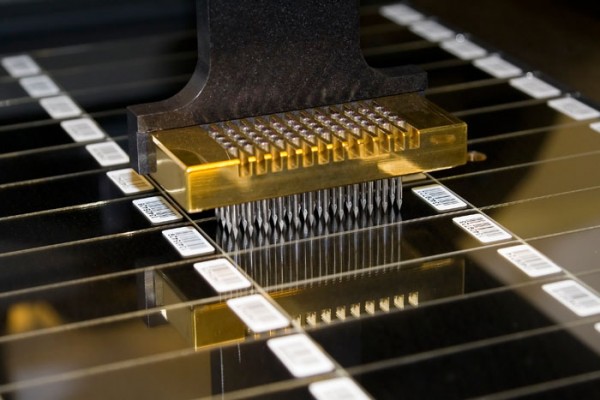With the inception of microarrays, their applicability has also evolved. Where there was the simple concept of microarrays being discussed at one time, now there are numerous types used for different purposes. While there are cheaper methods, there are those that have not been made commercially feasible so far. The latter are being worked upon but they are especially not useful for researches that are user-defined.
Printed Microarrays
The first milestone in the many types of arrays invented, printed microarrays use a microscope slide made of glass. Some of its main advantages includes that it is affordable. The glass slide is durable and lasts rigorous washing as well as high temperatures. Moreover, they are made in a way that the background does not have any fluorescence and there are no pores which improves the process of hybridization by improving kinetics. There are 2 types of microarray printers: contact and non-contact. The latter use the technique that goes behind the working of an ordinary computer printer.

In Situ-Synthesized Microarrays
These arrays have a very high density and make use of oligonucleotide probes that have been directly synthesized on the array surface. Since these situ-synthesized probes generally are short, a significant number has to be focused on a target in order to enhance sensitivity and specificity. This in turn also improves the statistical data recorded. However, because of its expense and complication, it is usually not feasible for customized development.
High Density Bead Microarrays
These arrays use silica beads (3 μm) that assemble themselves randomly on a substrate. This could be a Sentrix Beadchip or a Sentrix Array Matrix. The patterned beads are then used to detect the level of density of the nucleic acid that is being targeted. One of its most amazing benefits is that it can detect spatial bias by changing the sequence of the beads and retesting.
Electronic Microarrays
As is apparent from the name, these arrays use the electric field to transport the nucleic acid during active hybridization. The nucleic acid is negatively charged to be directed to a specific site after it has been positively charged and this is how the nucleic acid is send where needed. One of the main benefits of using this type of arrays is that they allow the detection of multiplex at a single test site because the same characteristic can be used for multiple queries.
Suspension Bead Microarrays
These arrays are three-dimensional, with the aim to focus on antibodies and antigens. The tool uses the concept of micropsheres for support and the cytometry flow is used for the detection of the targeted beads. The idea was put forward in 1977 until multiplexing was actually achieved.
The types of microarrays mentioned above are distinctive because of the methods they utilize to bring about the same result. This technology has helped gain insight into genes that are responsible for all characteristics of the body. Hence, there is a lot of importance attached to the invention of microarrays. It has made the development on finding cures many times quicker and easier for scientists.
Melanie Adams has a keen interest in microarrays and their development. She closely follows arrayjet.co.uk for the latest microarray instruments.

